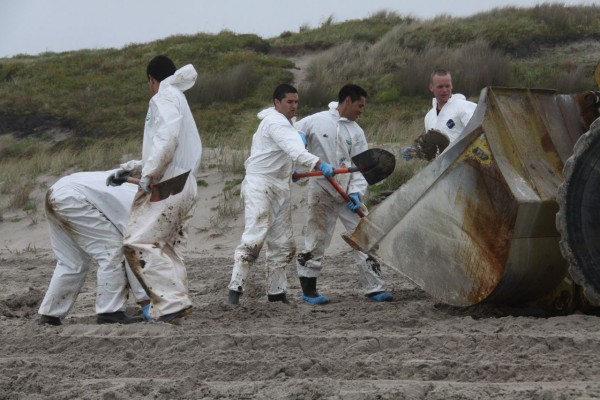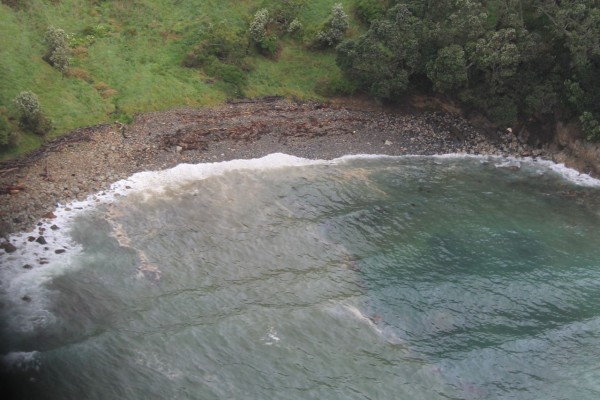Lost Rena Container “May Affect Seabed”
Maritime NZ says tonight that the container containing dangerous goods that has been lost from the Rena “is not considered a significant health risk.”
The container contains Alkylsuphonic liquid (UN2586), which is water soluble.
MNZ National On Scene Commander Nick Quinn says that “it may cause some localised effects to the seabed – we will be monitoring this.”
Google does not find anything significant of that spelling but if this is what he is talking about (spelling similar) , it says it’s toxic and combustible.
He denies media reports that the container held Ferrosilicon.
“However, our information is that if the Ferrosilican on board the vessel comes into contact with water we would see significant quantities of gas released in a short period of time.”
88 containers have been reported as fallen from the ship – 20 have come ashore.
A this time, salvage company Svitzer is responsible for collecting the containers in the water. The New Zealand Police and the Fire Service are assisting in managing the containers that have reached the shoreline. A company which specialises in overboard container management will take over once plans have been approved.
In other developments:
- The ship has a 22 degree list
- 350 tonnes of oil has leaked
- 500 dead birds have been recovered
- Overseas news sites have published the captain’s name
- Rena’s company has apologised
- Corexit 9500 dispersant is no longer being used
The cargo ship Rena is now on a list of about 22 degrees to starboard. The aft of the vessel remains free floating at high tide while the bow is pinned on the reef.
There is a large spilt in the port and starboard hull.
A salvage inspection team was winched aboard the Rena this morning to check the damage to the vessel and assess whether its power systems were still intact. The priority was to make sure the vessel was safe to be boarded.
The team has assessed the vessel as safe to operate from.
The hoses used to transfer the oil from ship to ship are reportedly largely undamaged and the pumps have no major damage. However, the vessels auxiliary power system is probably not operable. There are helicopters, rigid inflatable boats, tugs and Navy ships all standing by to assist the salvage operation.
It is estimated that about 350 tonnes of oil has leaked from the Rena.
The oil spill emergency teams are now dealing with three types of pollution – the containers, the contents of the containers, and the oil.
There were 500 people on the beaches today cleaning up the oil and assessing the potential impacts on shorelines around the Bay of Plenty.
A total of 95.45 tonnes of solid waste and 6 tonnes of liquid waste had been taken to the waste transfer station as at 5pm.
The heaviest concentration of oil coming onto the beach has been at Papamoa . The oily waste is being collected by two approved waste companies and managed through a consented waste management plan.
Beach access has been restricted in the area from Mount Maunganui to Maketu Point, including the Maketu Estuary.
Corexit 9500 dispersant which has been criticised by Greenpeace and the Green Party is no longer being used.
Nick Quinn says that is because its “has been shown as insufficient to justify aerial application to the spilled oil. We have consequently ended the aerial application trials and will continue to assess all response options.”
Mr Quinns says they are in for a long operation to clean up the oil, and the same beaches will get re-oiled and re-cleaned on a daily basis.
“This is where it gets exasperating but we have experience in this and will just continue working through the process.”
There have been offers to the oil spill response team of heavy equipment to assist the clean-up operation, however, Mr Quinn said experience had proven this could push oil into the sand and cause further damage to the environment. “We are considering all oil spill response options, but right now the basic shovel is top of the list, in terms of removing oil from the beach.”
500 dead birds have been recovered.
Mr Quinn said it was heart wrenching to see the state of some of the birds coming into the centre.
“The mortality rates are starting to increase and there are several hundred dead birds yet to be collected by the wildlife teams who are working methodically to deal with the oiled birds coming in.”
The team had also been pre-emptively catching rare New Zealand dotterels, which would be resettled in a special area in the wildlife facility. There are now about 70 birds, four seals and 13 dotterels in the centre.













0 Comments
You can be the first one to leave a comment.